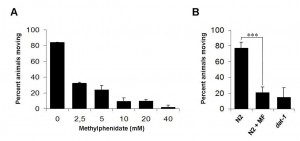The catecholamine dopamine (DA) is a neurotransmitter that regulates behavior in both vertebrate and invertebrate animals. In humans, altered DA signaling is involved in several mental disorders. DA signaling mechanisms are regulated by environmental factors and various essential components encoded by genes involved in DA synthesis, release, reuptake, and response. The human SLC6A3 gene encodes the dopamine transporter (DAT), a sodium- and chloride-dependent member of the solute carrier family 6 widely distributed throughout the brain in areas of dopaminergic activity. DAT provides reuptake of DA from the synaptic cleft modulating the neurotransmitter signal. There are data supporting the role of DAT in attention deficit disorder, bipolar disorder, clinical depression and addiction disorders.
In C. elegans, the dat-1 gene encodes a plasma membrane DAT-1, which is predicted to regulate dopaminergic neurotransmission via reuptake of dopamine into the presynaptic neuron. The DAT-1 protein is ortholog of the human SLC6A3. Swimming-induced paralysis (SWIP) is a phenotype of C. elegans described in dat-1-deficient mutants (Mcdonald et al., 2007). It has been proposed that the SWIP phenotype appears in DAT-1-deficient nematodes because in water animals have to exert maximal motor activity, which demand efficient clearance of dopamine mediated by the dopamine transporter (Mcdonald et al., 2007).
Given that the synaptic action of DA is inactivated by reuptake of this neurotransmitter into the nerve terminals from which they are released, the transporter is target for psychostimulants and antidepressant. Thus, methylphenidate is a drug that blocks the human DAT, and it is used widely for treatment of several mental affections including attention deficit hyperactivity disorder.
Here we show that methylphenidate is functional in C. elegans. Figure 1A illustrates a dose-response of C. elegans to methylphenidate indicating that this drug induces SWIP in N2 wild type strain. The SWIP phenotype of N2 animals in presence of methylphenidate (9.3 mM) was similar to that of dat-1(ok157) mutant used as control (Figure 2B). These results suggest that in C. elegans methylphenidate, as in mammals, acts inhibiting the dopamine transporter. In this regard, the worm dopamine transporter DAT-1 protein has 42% aminoacid sequence identity with the human SLC6A3 protein.
Figures

References
McDonald PW, Hardie SL, Jessen TN, Carvelli L, Matthies DS, Blakely RD. (2007) Vigorous motor activity in 




